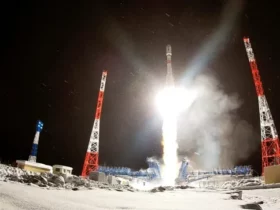If you think space exploration is all about glittering stars and dazzling galaxies, think again. The James Webb Space Telescope (JWST) is now giving us a sneak peek into a far less glamorous but equally fascinating side of the cosmos: brown dwarfs. Dubbed the “failed stars,” these enigmatic objects reside somewhere between planets and stars, too small to sustain nuclear fusion but too large to be called planets. And where better to spot these elusive bodies than in the Orion Nebula, a cosmic nursery just 1,300 light-years away?
So, what exactly did the Webb Telescope uncover in this stellar breeding ground? Pull up a chair, because these findings are about to blow your mind.
Table of Contents
ToggleA Stellar Detective Story: Why the Orion Nebula?
The Orion Nebula has always been a goldmine for astronomers. For decades, it’s been the backdrop for exploring the life and formation of stars. The Hubble Space Telescope famously captured images in the ’90s, revealing protoplanetary discs—proplyds—around newly formed stars. These findings stoked the imaginations of astronomers everywhere, hinting at the formation of solar systems not so different from our own.
Yet, even with Hubble’s powerful eye, there were still lingering mysteries. Were some of these proplyds merely around young stars, or could they also surround the elusive brown dwarfs? Enter the JWST, equipped with cutting-edge infrared capabilities that can slice through cosmic dust to reveal what Hubble simply couldn’t see.
Cracking Open the Brown Dwarf Mystery
To get an idea of just how revolutionary JWST’s discoveries are, let’s rewind for a second. Brown dwarfs occupy a peculiar place in the cosmic lineup. Picture them as the underdogs of the star world—big enough to briefly ignite deuterium (a heavy form of hydrogen) but not massive enough to keep the fires of nuclear fusion going. Think of them as flickering candles in the cosmos, burning out almost as soon as they light up. Because of their faint infrared emissions, brown dwarfs are notoriously hard to spot.
JWST’s high-powered infrared capabilities have changed the game. Using its near-infrared spectrograph, the telescope identified twenty brown dwarfs lurking within the Orion Nebula. Here’s where it gets juicy:
- Some of these brown dwarfs are downright tiny, with masses as low as five times that of Jupiter—barely 0.5% of the Sun’s mass.
- Two objects lie on the delicate threshold between the smallest stars and the largest brown dwarfs, challenging our understanding of where stars end and brown dwarfs begin.
- And remember those proplyds that Hubble found back in the ’90s? Two of them have now been confirmed as the coolest, faintest brown dwarfs ever identified.
These revelations don’t just fill gaps in our knowledge—they kick the door wide open, inviting more questions about how brown dwarfs form and what they could mean for our understanding of stellar and planetary evolution.
Why This Matters: More Than Just Failed Stars
This isn’t just about finding more cosmic oddballs to add to an interstellar collection. Studying brown dwarfs gives scientists critical insights into the processes that shape stars and planets. For instance, the discovery of protoplanetary discs around brown dwarfs implies that these objects might host mini solar systems. Imagine that—a world of failed stars with their own planets and moons. How’s that for a twist?
Kevin Luhman, an astronomy professor at Penn State and one of the lead researchers on this project, believes we’ve barely scratched the surface. “There could be hundreds more brown dwarfs within the nebula,” he notes, “and JWST is just getting started.” With future observations, we might uncover even more brown dwarfs and learn about their fascinating, often-overlooked role in the cosmic ballet.
The Future of Brown Dwarf Exploration
The JWST has only just begun its exploration of the Orion Nebula, and already it’s proving itself to be an indispensable tool for solving age-old astronomical puzzles. Armed with JWST’s data, scientists are gearing up for a fresh wave of research to better understand how brown dwarfs fit into the larger story of stellar evolution. Could they be the missing link between planets and stars? Only time, and more JWST observations, will tell.
So, next time you look up at the night sky, remember that it’s not just stars and planets up there. There’s a whole hidden world of brown dwarfs, quietly orbiting through the cosmos, waiting for us to uncover their secrets. And thanks to the JWST, we’re closer than ever to finding out what those secrets are.













Leave a Reply